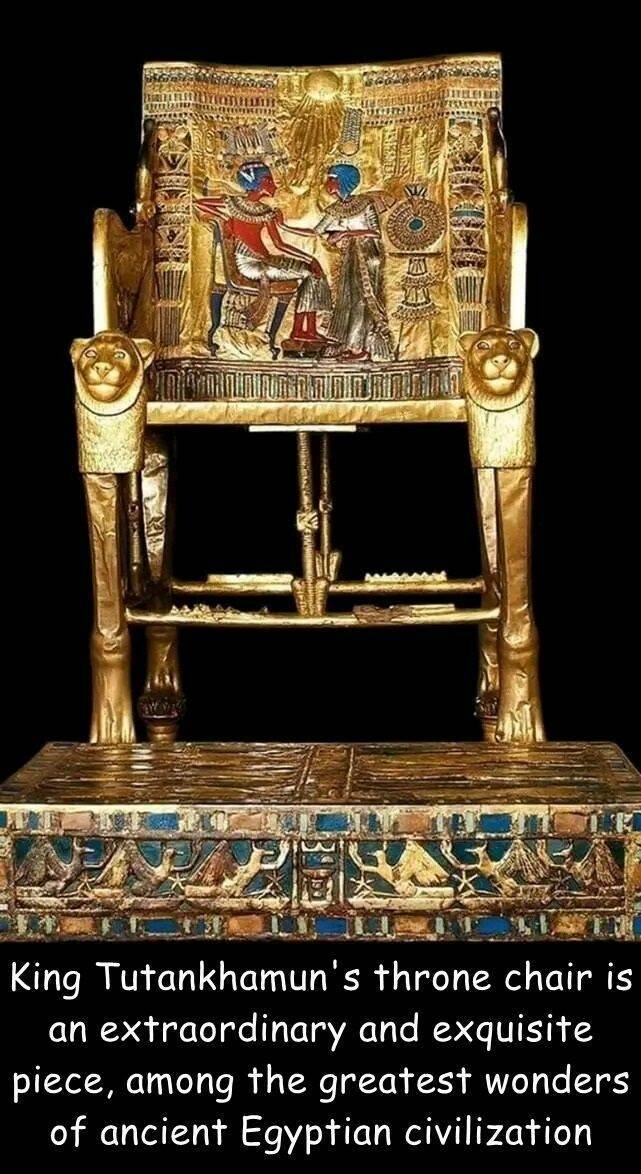#king tutankhamun
Text
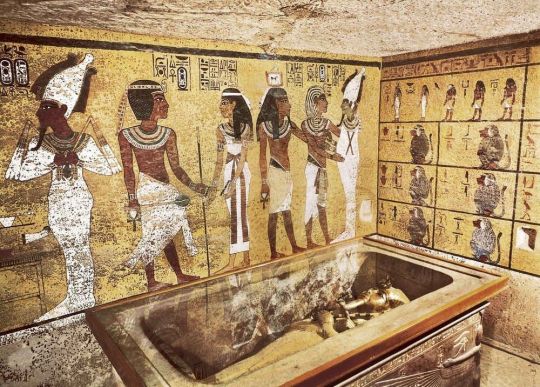
‘Curse’ Behind King Tutankhamun’s Tomb Mysterious Deaths Finally Solved
The unsettling curse of King Tutankhamun’s tomb in Egypt has bewildered archaeologists since it’s been feared to be linked to the mysterious deaths of multiple excavators who discovered it in 1922.
However, a scientist now claims to have solved the mysteries of the infamous “Pharaoh’s Curse” more than 100 years later.
Toxic levels of radiation emanating from uranium and poisonous waste are believed to have lingered inside the tomb since it was sealed over 3,000 years ago, Ross Fellowes wrote last month in the Journal of Scientific Exploration (JSE).

The burial chamber in the tomb of Tutankhamun, near Luxor, Egypt.
The radiation level inside Tutankhamun’s tomb is so high that anyone who comes in contact with it could very likely develop a fatal dose of radiation sickness and cancer.
“Both contemporary and ancient Egypt populations are characterized by unusually high incidences of hematopoietic cancers, of bone/blood/lymph, for which a primary known cause is radiation exposure,” Fellowes wrote in his study.
However, this radioactivity isn’t isolated to Tutankhamun’s tomb.
Fellowes revealed that “unusually high radiation levels have been documented in Old Kingdom tomb ruins” and spread throughout sites in Egypt.
“Radiation has been detected by the Geiger counter at two sites at Giza adjacent to the pyramids,” he wrote, adding that radon — a radioactive gas — has also been detected in “several underground tombs at Saqqara.”
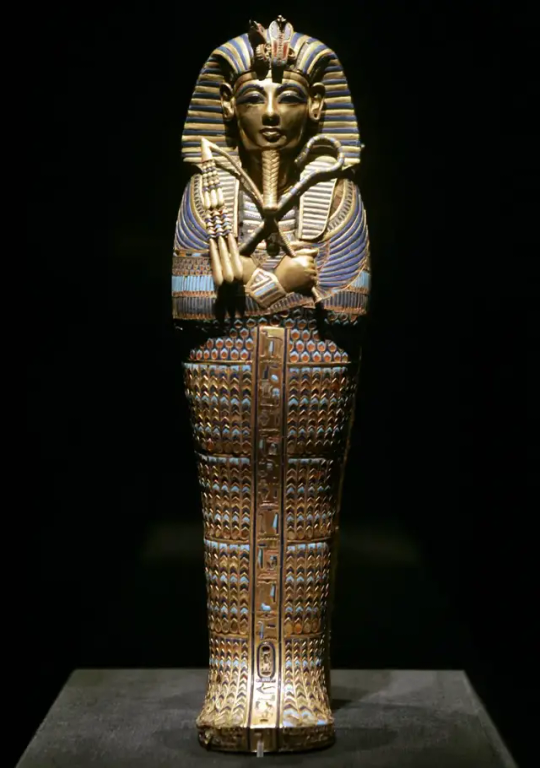
The “Coffinette for the Viscera of Tutankhamun,” which contained the king’s mummified liver, depicts him as Osiris, holding a crook and flail.

Medical imagery of Tutankhamun is shown above a replica of King Tut’s skull on display during the “Tutankhamun And The Golden Age Of The Pharaohs” at the Los Angeles County Museum of Art in California.
These readings were all found to be “intensely radioactive.”
“Modern studies confirm very high levels of radiation in ancient Egyptian tombs, in the order of 10x accepted safety standards,” the study shared.
It’s also theorized that those who built the ancient tombs were aware of the toxins based on the eerie warnings carved on the walls.
“The nature of the curse was explicitly inscribed on some tombs, with one translated presciently as, ‘they that break this tomb shall meet death by a disease that no doctor can diagnose,’” Fellowes wrote.
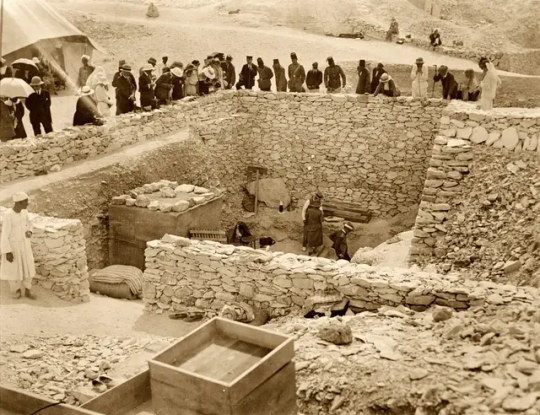
Outside the tomb of Tutankhamun during the 1922 excavation in the Valley of the Kings in Egypt.
Other ominous translations like “forbidden” because of “evil spirits” may have significantly fueled the fear that supernatural curses lingered in the ancient sites.
Those fears intensified with the mysterious deaths of Lord Carnarvon, who funded the excavation in 1922 and reportedly walked through the treasured filled rooms — and multiple others after they unsealed the tomb.
“Carnarvon was dead within a few weeks of the uncertain diagnosis of blood poisoning and pneumonia,” Fellowes wrote.
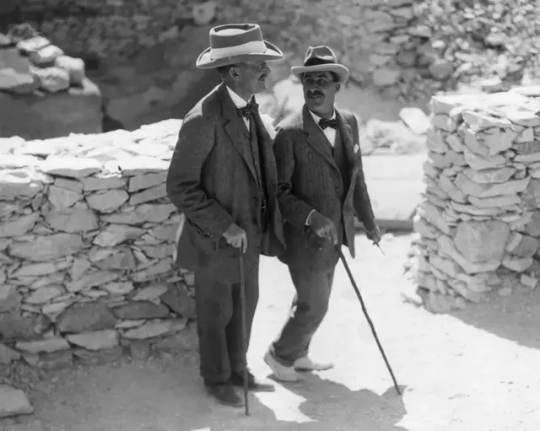
Egyptologist Howard Carter (R) walks with archaeologist Lord Carnarvon, the patron of his research, outside the tomb of King Tutankhamun in 1922.
Egyptologist Arthur Weigall allegedly told colleagues that Carnarvon would “be dead within six weeks” upon entering, the study claimed.
Howard Carter, the first person to walk inside Tutankhamun’s tomb with Carnarvon, died in 1939 after a long battle with Hodgkin’s lymphoma, which was suspected to be caused by radiation poisoning.
British Egyptologist and independent excavator Arthur Weigall was present at the opening of Tut’s Tomb and is also credited with starting the ‘myth’ of the curse.
He died of cancer at 54 years old in 1934.
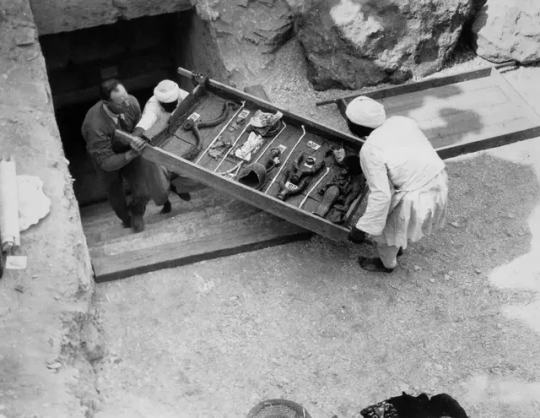
Workers remove a tray of chariot parts from the Tomb of Tutankhamun in the Valley of the Kings, Egypt, in 1922.
In total, six of the 26 people present when the tomb was opened died within a decade from asphyxia, stroke, diabetes, heart failure, pneumonia, poisoning, malaria and X-ray exposure.
While the deaths can be seen as odd, the curse theory was also likely fueled by the oddities that happened when it opened.
Carnarvon had reportedly suffered a mosquito bite that became severely infected.
Around the time excavators opened the tomb, Cairo reportedly suffered a bizarre power outage and a freak sandstorm, according to National Geographic.’
At one point during the excavation, Carnarvon’s favorite dog allegedly let out a chilling howl and suddenly dropped dead.
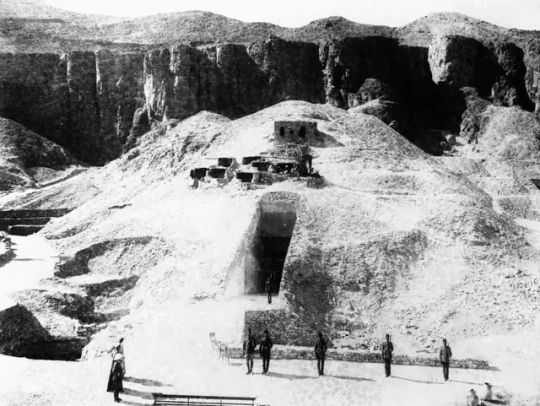
A photograph showing guards standing outside the tomb of Tutankhamun in Egypt in 1922.

A sacred cow being removed from Tomb of Tutankhamun in 1922.
From a historical perspective, the discovery of the tomb in the Valley of Kings is considered one of the most fascinating finds that gave modern society a glimpse into the Egyptian royalty voyage into the afterlife.
Five thousand items, including solid gold funeral shoes, statues, games, and strange animals, were discovered inside Tutankhamun’s tombs.
It would take the excavators ten years to clear the tomb of its treasure.
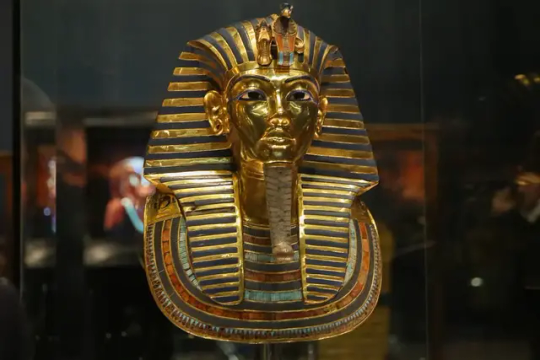
The golden funerary mask of Tutankhamun.
The unsealing and studying of the tomb is also credited with launching the modern era of Egyptology.
Tutankhamun took the throne as pharaoh around nine or ten years old and ruled between 1332 BC and 1323 BC.
However, he died by the time he turned 18.
There are no surviving records of Tutankhamun’s death and how the young pharaoh died remains a mystery.
However, Tutankhamun is suspected to have suffered from several health issues — likely linked to his father, Akhenaten, and his mother, Nefertiti, being brother and sister.
By Richard Pollina.
#‘Curse’ Behind King Tutankhamun’s Tomb Mysterious Deaths Finally Solved#King Tutankhamun#Pharaoh’s Curse#Old Kingdom#Valley of the Kings#Lord Carnarvon#Howard Carter#Egyptology#ancient artifacts#archeology#archeolgst#history#history news#ancient history#ancient culture#ancient civilizations#ancient egypt#egyptian history#egyptian mythology#egyptian pharaoh#egyptian antiquities#egyptian art
60 notes
·
View notes
Text
"Don't worry J-man, I'm gonna bring the yucks hardcore."
- Sydnee McElroy to her dear and loving husband with whom she shares two children with
#sydnee mcelroy#justin mcelroy#sawbones a marital tour of misguided medicine#sawbones#samtomm#justin and sydnee mcelroy#the mcelroy family#the mcelroys#king tutankhamun
97 notes
·
View notes
Text
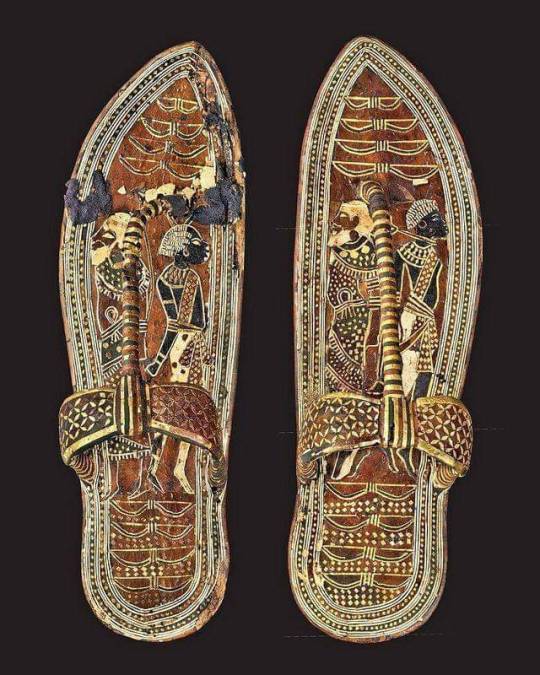
Egyptian King Tutankhamun's 3300 years old sandals
#egyptian king#rey egipcio#king tutankhamun#rey tutankhamun#3300 years old#sandals#museum of egyptian antiquities#cairo#el cairo#egypt#egipto#africa
98 notes
·
View notes
Text
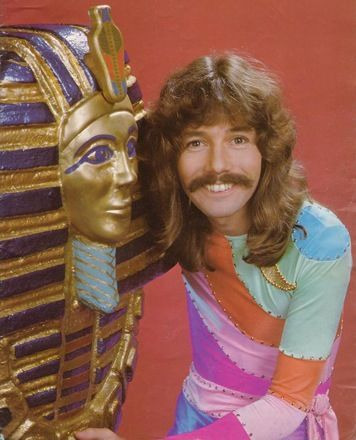
Doug Henning And Friend
#Photography#Vintage#Magicians#Doug Henning#Egyptology#Sarcophagus#King Tutankhamun#Tutankhamun#1970s#70s#Fashion
61 notes
·
View notes
Text
100 year anniversary of the discovery of King Tutankhamun’s tomb!! Howard Carter found it on November 4, 1922 but had to wait to open it until his financial backer Lord Carnarvon came on the 25th.
53 notes
·
View notes
Text
An overview of The King Tutankhamun Death Mask
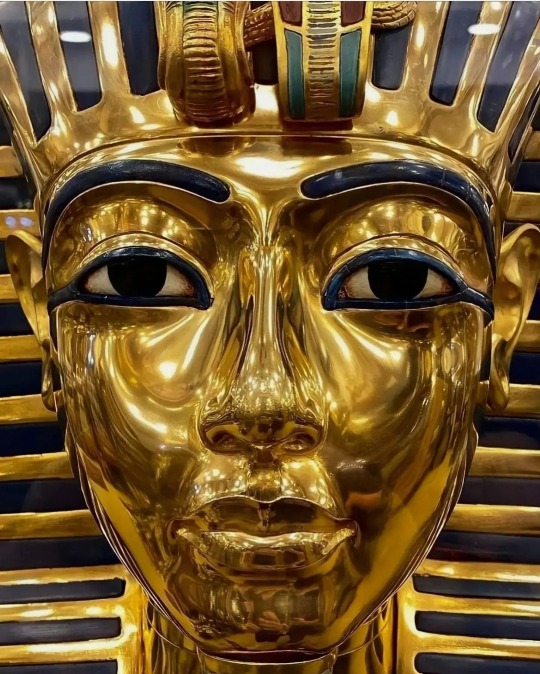
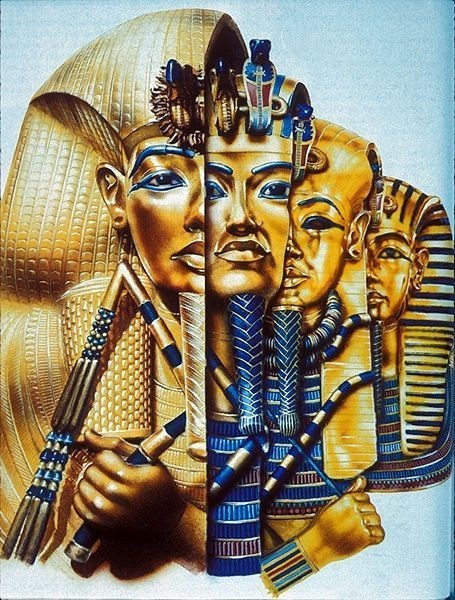
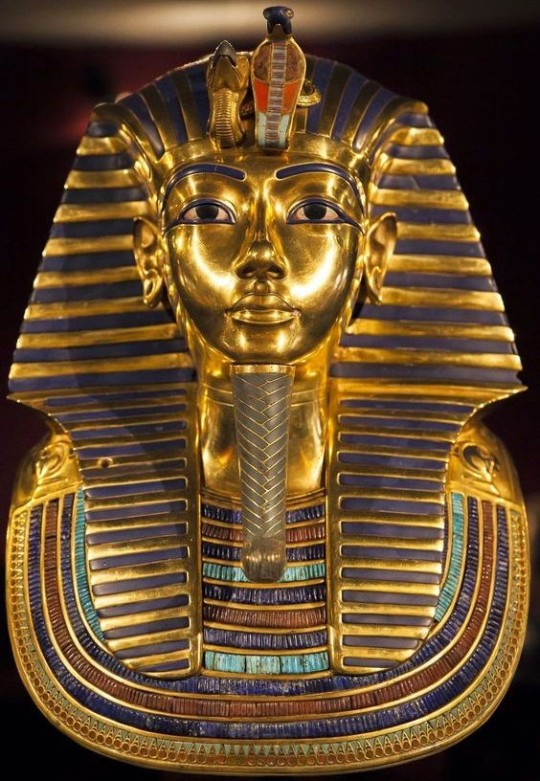

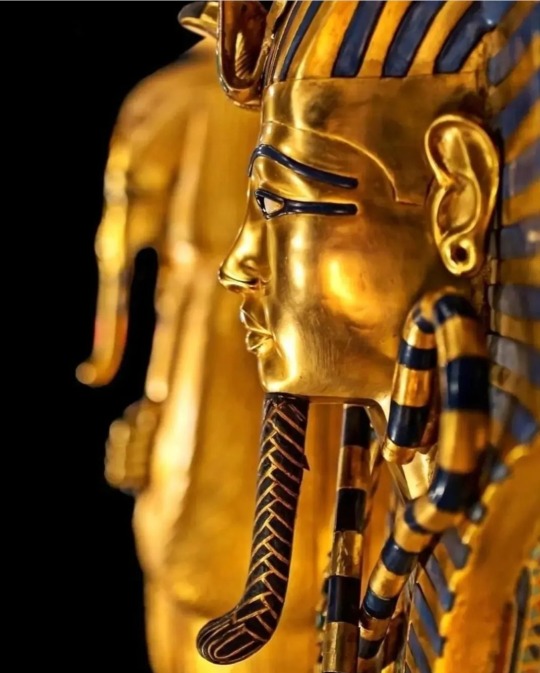
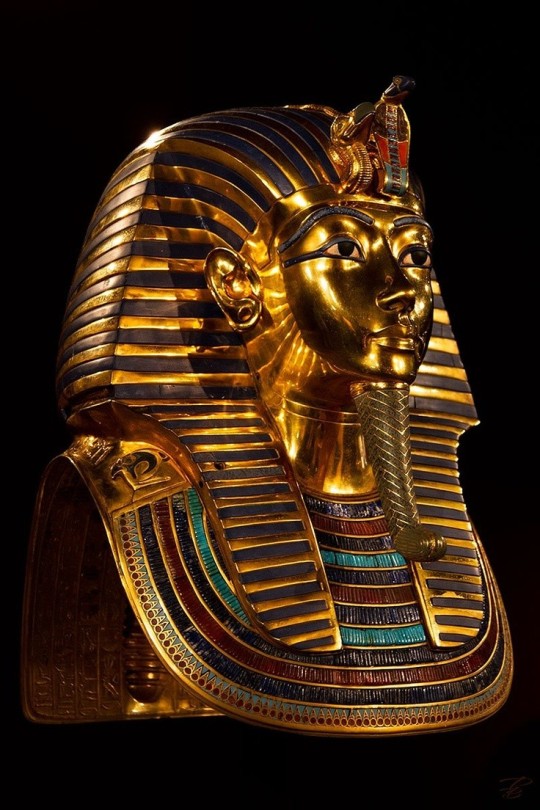
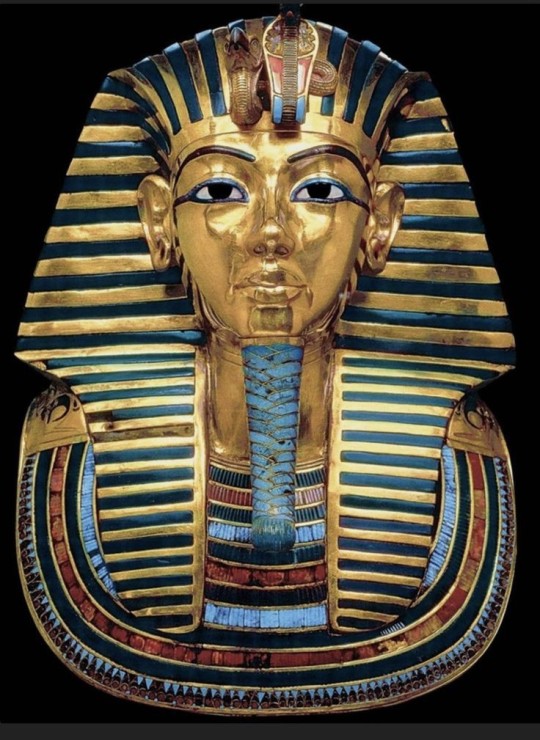
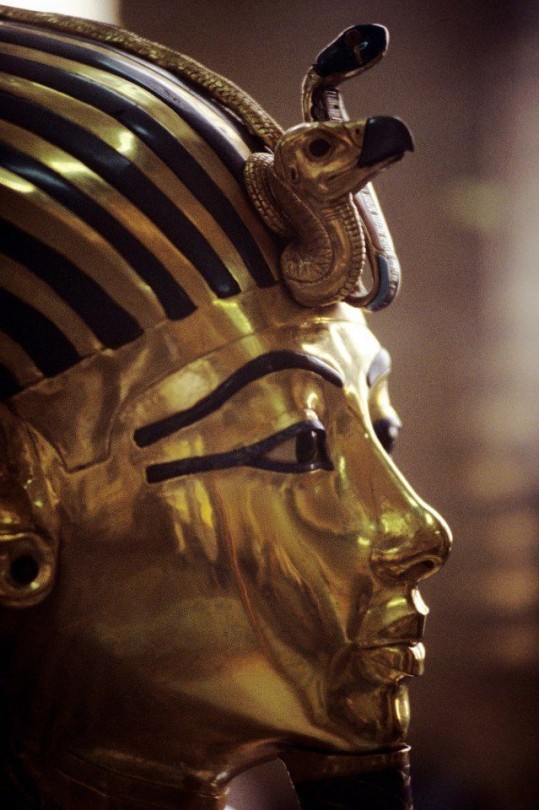
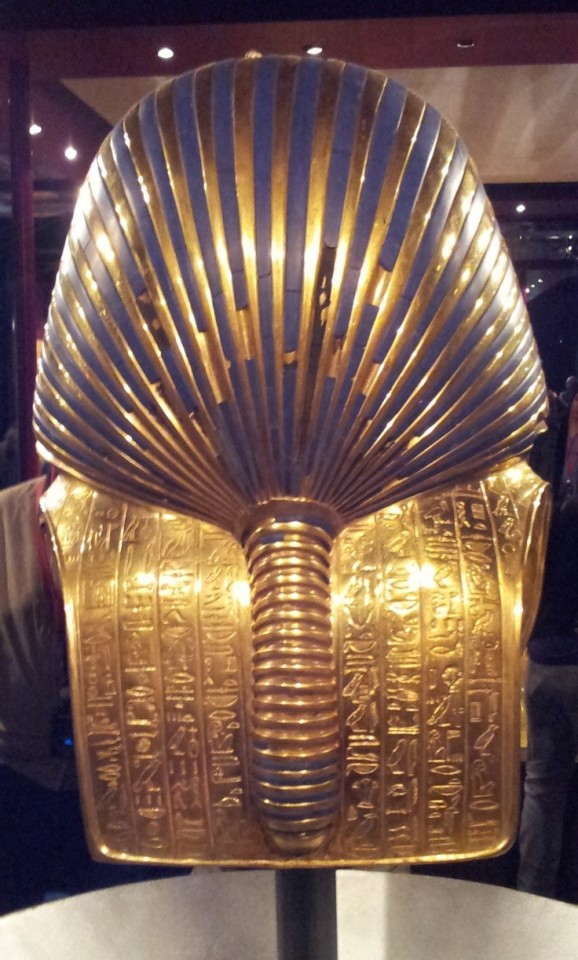
4 notes
·
View notes
Photo


November 4, 2022 | Microsoft Bing
One hundred years ago, Howard Carter and company discovered the tomb of King Tut, which had remained untouched for thousands of years. In commemoration of this event, Microsoft Bing included a mini image of the king (pharaoh) in his golden mask n the Search bar as well as some articles on interest: “Who was King Tut,” “Secrets of the tomb revealed,” and “Inside Egypt’s pyramids.”
[Screenshots of desktop, Microsoft Bing]
#l'egypte est partout#egypt#ancient egypt#king tut#King Tutankhamun#tutankhamun#microsoft bing#bing#tut#howard carter#valley of the kings
11 notes
·
View notes
Text

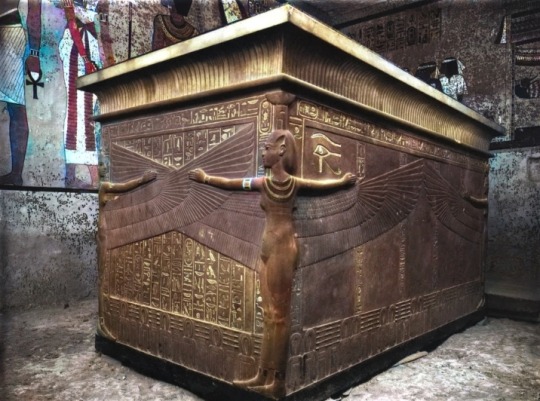
The sarcophagus in the burial chamber of King Tutankhamun, 1923.
📷: Harry Burton
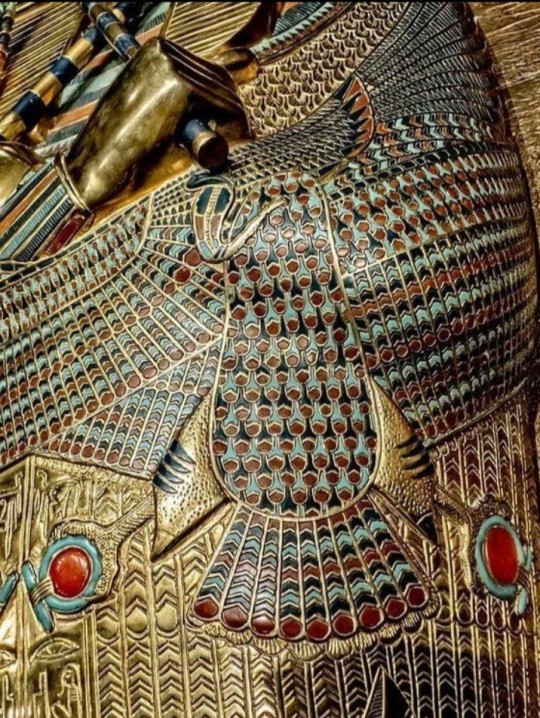
Closeup of the uraeus on the body of King Tutankhamun’s first inner coffin.
New Kingdom, 18th Dynasty Egypt, 1332-1323 BCE
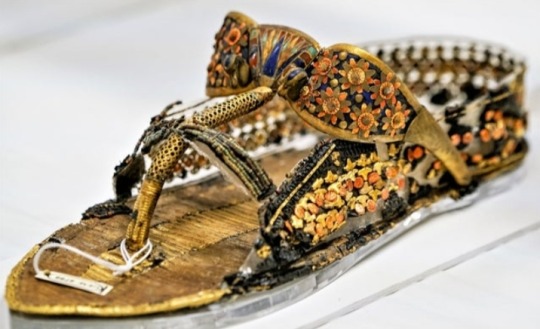
King Tutankhamun's sandal made of leather, gold and faience.
#King Tutankhamun#Ancient Egypt#Egyptian Civilization#Eighteenth Dynasty#KV62#pharaoh#Valley of the Kings#Tutankhamun's tomb#New Kingdom of Egypt#Tutankhamun's mummy#King Tut
6 notes
·
View notes
Text
happy 100th anniversary to white people robbing graves the discovery of king tutankhamun's tomb!
6 notes
·
View notes
Text
I'm so curious about how Tutankhamun was as a person. I mean his personnality, what he liked what he disliked etc... It's something we will never know 🥹
3 notes
·
View notes
Photo
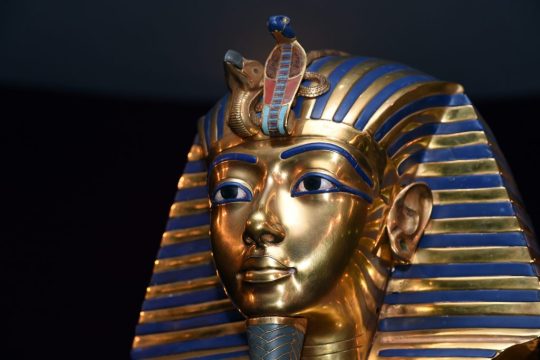
The 5 Most Opulent Artifacts Found in King Tut’s Inner Tomb
All that glitters is sometimes gold—particularly when it comes to the tomb of King Tutankhamun.
There is perhaps no other period in human history that has captured minds and imaginations quite like ancient Egypt. “Egyptomania,” or the intense interest in all thing Egypt, was first sparked by Napoleon’s Egyptian Campaign at the turn of the 19th century. Throughout the 1800s, people across the world emulated the architecture and design of Egyptian culture—for example, Victorian-era jewelry frequently incorporated scarabs, and cartouches and monuments across Europe took the form of obelisks.
The pervasive obsession with Egypt reached an apogee when on November 26, 1922, archaeologist Howard Carter and his team discovered the doorway to the tomb of Pharaoh Tutankhamun (commonly referred to as King Tut) in the Valley of the Kings on the west bank of the Nile. Though archaeological digs had been undertaken throughout the area, most tombs had succumbed to looting and grave robbing, leaving them stripped bare of their original contents. Tut’s tomb, however, had been hidden by debris and rubble, preserving it to near perfect condition.
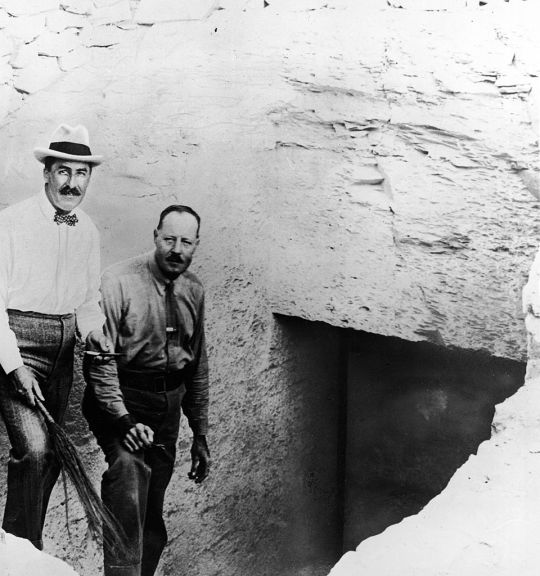
Despite discovering King Tutankhamun’s tomb in late 1922, it took several months for archaeologists to work their way through and catalogue the contents within the outer chambers. On February 16, 1923, Carter finally came face-to-face with the doorway leading to the tomb’s inner burial chamber and unsealed it. What he and his team were met with was the most well-preserved and intact pharaonic tombs ever found. Over the following eight years, the items and goods contained therein were carefully catalogued and removed, and today are held in the collection of the Egyptian Museum in Cairo.
To mark the centennial of the unsealing of the burial chamber, we’ve gathered five of the most opulent and intriguing artifacts that were found in King Tutankhamun’s tomb.
Tutankhamun’s Sarcophagus and Three Coffins:

Seeing the sarcophagus was perhaps one of the most exciting moments for the archaeologists at the time, as it indicated early on that the contents were preserved and intact. Crafted of quartzite and red granite, and displaying the images of Isis, Nephthys, Neith, and Serqet, the sarcophagus housed three nesting coffins which held Tutankhamun’s mummified body. The outer two coffins are made of fully gilded wood and inlaid with glass and semiprecious stones, such as turquoise and lapis lazuli. The innermost coffin, however, is made almost entirely out of 110.4 kilos of solid gold, similarly adorned with inlaid stones, and incised with inscriptions and in the shape of Osiris holding scepter and flail.
The Death Mask of Tutankhamun

Found within the innermost coffin upon the mummified body, King Tut’s death mask has become a world-recognized icon of ancient Egypt and the pharaonic era. Composed of 10.23 kilos of solid gold, it depicts Tutankhamun wearing the traditional stripped pharaonic headdress replete with representations of the goddesses Nekhbet and Wadjet above his brow. The mask’s back and shoulders are inscribed in Egyptian hieroglyphs with a protective spell copied from the Book of the Dead, offering protection as the pharaoh moved through the underworld.
Canopic Shrine

In the process of mummification, many of the person’s organs are removed and placed in what are called canopic jars. These containers frequently included lids shaped after the heads of the Sons of Horus, protective deities. Like many other ancient Egyptian tombs, King Tut’s included an alabaster canopic chest containing the four separate jars. However, in the pharaoh’s tomb, these were housed in a canopic shrine. Standing at six-and-a-half feet tall and enrobed in gold, the shrine includes the figure of the goddess Nepthys who stands guard over the royal contents.
Golden Sandals
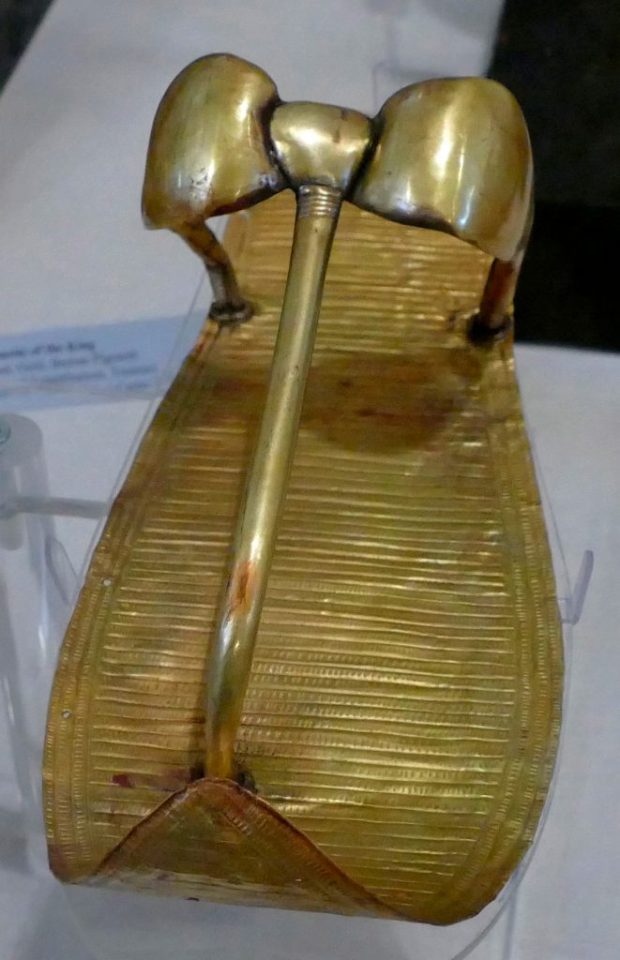
A large swathe of the items found in King Tutankhamun’s tomb represented personal necessities, such as clothing, toiletries like perfume, and food stuffs. Included among these items were a pair of gold sandals. These golden shoes have been found in numerous other ancient tombs, and it is believed that they were made specifically for funerary and burial practices. The soles of the shoes depict the nine traditional enemies of Egypt, including the Nubians and Libyans, symbolizing that as god-king they were literally beneath his feet.
Golden Chariot
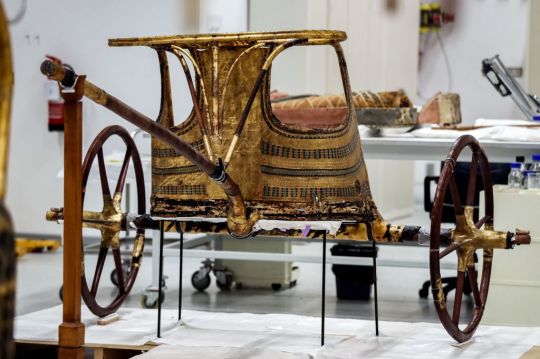
King Tutankhamun’s tomb contained a total of six golden chariots—though, unfortunately, all were in various states of disrepair as they were either mishandled or damaged by looters. After restoration, they were identified as typical D-cab chariots that were meant to be drawn by two horses. The image of a pharaoh driving a chariot was a common symbol of royal power and wealth, and in ancient times, pharaohs were often presented at public events in opulent chariots to highlight their status.
By Annikka Olsen.
#The 5 Most Opulent Artifacts Found in King Tut’s Inner Tomb#King Tutankhamun#Howard Carter#ancient tombs#ancient graves#ancient artifacts#archeology#archeolgst#valley of the kings#gold#treasure#history#history news#ancient history#ancient culture#ancient civilizations#ancient egypt#egyptian history#egyptian pharaoh#egyptian art
50 notes
·
View notes
Photo

2 notes
·
View notes
Text

King Tutankhamun and his wife Ankhesenamun scene in their garden, ivory plaque from the lid of a coffer from the tomb of the king Tutankhamun discovered in the Valley of the Kings, 14th century BC. XVIII dynasty, Thebes, EGYPT
#king tutankhamun#queen ankhesenamun#rey tutankhamun#reina ankhesenamun#valley of the kings#valle de los reyes#dynasty xviii#dinastia xviii#14th century#siglo 14#BC#AC#thebes#tebes#egypt#egipto#africa
62 notes
·
View notes
Text
The Iconic Mask of King Tutankhamun
In 1922, Howard Carter and a group of dignitaries opened the sealed door to a tomb he discovered in Egypt’s Valley of the Kings. A significant fortune awaited the discoverers, and they were astounded by the stroke of luck that led them to unearth the sole tomb of a pharaoh that had remained unscathed and undisturbed for millennia. The iconic mask of King Tutankhamun lay closest to the king’s…
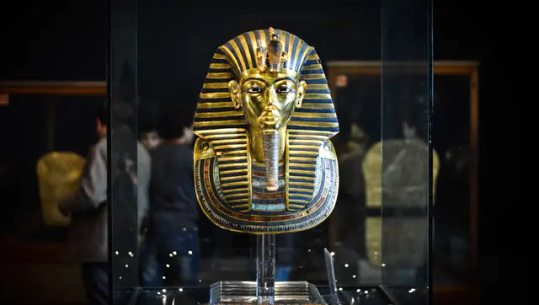
View On WordPress
#akhenaten#amun#ancient art#ancient egypt#archeology#art#art and history#art hsitory#artifacts#culture#discovery#egypt#egyptian#Egyptian history#gold#history#king#king tutankhamun#mask#mummy#museum#pharaoh#pharaohs#religion#shrine#symbol#throne#tomb#travel#Tutankhamun
1 note
·
View note
Text
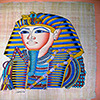
Unveiling the Mysteries of golden masks King Tutankhamun: The Tomb, The Mask,
King Tutankhamun, also known as King Tut, was an Egyptian pharaoh who ruled from around 1332 to 1323 BC during the 18th dynasty. He is known for his relatively short reign and for the discovery of his tomb, which was one of the most significant archaeological discoveries of the 20th century
reed more'
#Here are some potential keywords for marketing a papyrus of the Golden Mask of King Tutankhamun:#King Tutankhamun#Ancient Egypt#Golden Mask#Pharaoh#Papyrus Art#Egyptian Art#Hieroglyphics#History#Artifacts#. Archaeology#Royalty#Treasures#Museum-Quality#Decora#Collectible
1 note
·
View note
